‘Be Vegan, Be Active, Get Serious!’ – Interview with ex-slaughterhouse worker Carl Scott
Posted on April 22, 2022
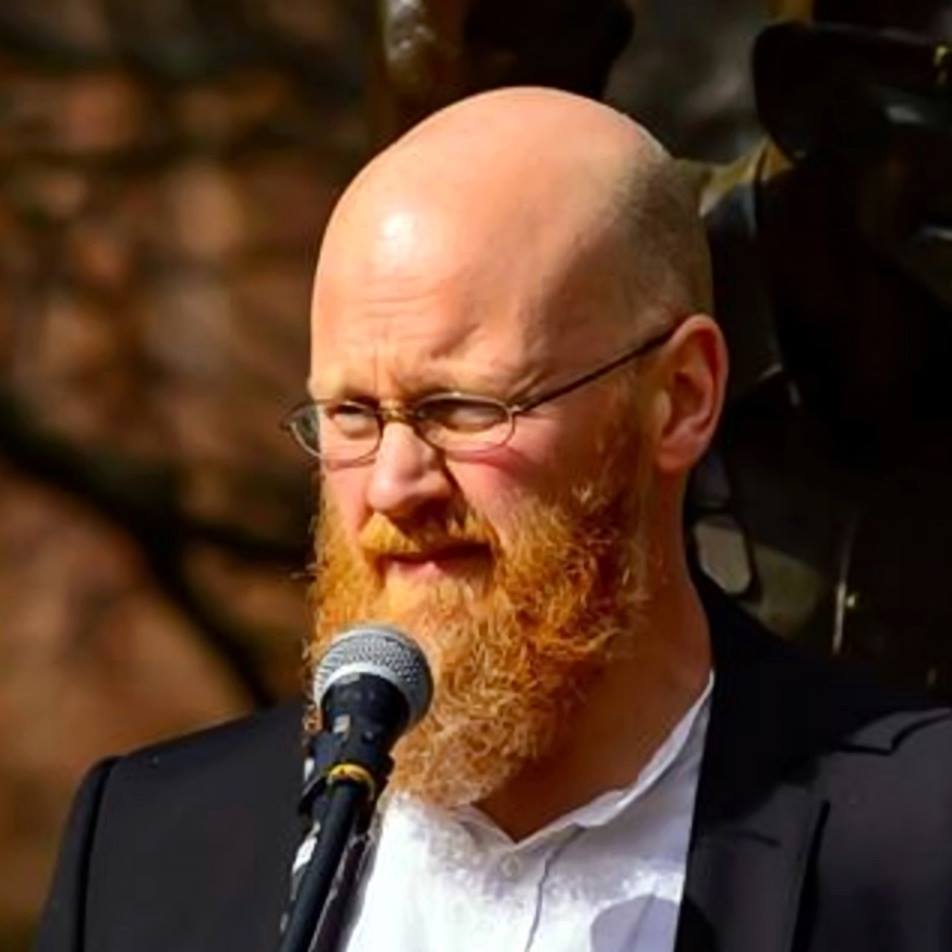
Well-known New Zealand animal activist Carl Scott is a former slaughterhouse worker and ex hunter, who also worked as a medic in the Army. At the age of 40 Carl made the commitment to go vegan, and has been a passionate and outspoken advocate for animals and veganism ever since. In this interview with End Animal Slaughter’s Sandra Kyle, Carl talks about his background, his slaughterhouse work, his ‘conversion’ to veganism, and his activism. Carl also shares his personal struggles, and offers radical advice to those working for the liberation of animals in 2022 and beyond.
Reading time: 12 minutes

High School Art project. Carl made it at the age of 15 in honour of his father and his slaughterhouse worker friends.
Q1: Carl, when and why did you start working in a slaughterhouse?
It was not long after my 20th birthday, in November 1989, that I started work at the Pukeuri freezing works. ‘Freezing works’ is a common Kiwi term for slaughterhouses. It is located near Oamaru, in the South Island of New Zealand and it is still operating. Employment was sky high at the time, and I couldn’t get a job in Waimate, where I was living. It was definitely not my dream job, but my father knew the personnel officer at Pukeuri, and he helped me get in. The money was really good too, so that helped.
Q2: What did you do there?
I mainly worked on ‘the mutton chain’ where they processed the lambs and sheep. My first job was on the gut trays, processing the hearts, lungs, livers, kidneys, intestines, and so on. In my second or third season there they also had me working on ‘the detain rail’. On the main chain there are meat inspectors who check the dead bodies for disease, damage, and contamination. If they find something, then the body goes onto a separate rail called the detain rail, and we would clean them up before they went back onto the main rail.
I also worked in the pet food department a couple of times. The pet food guys would put all sorts of offcuts deemed unfit for human consumption into a giant vat. It was kind of like a giant cake mixer, that mashed it all up, and then it was made into pet roll. The main thing I remember there is the disgusting smell. It wouldn’t surprise me if a lot of shit and pus ended up in those pet rolls.
I also relieved in the chiller room occasionally, moving the dead bodies around and transferring them from one overhead track to another, sorting the carcasses by what international destination they were going to. It was pretty cold in the chiller, and the people working there had to wear extra layers of clothing.
I did a few other jobs on the mutton chain, and once or twice I also worked in ‘the beef house’ where they processed the cattle. Down there, I had to stamp the carcasses with red ink to verify they had passed inspection, then I had to move the bodies between different rails. Although the cows’ bodies were cut in half, they still weighed a lot, and it was reasonably physically demanding.
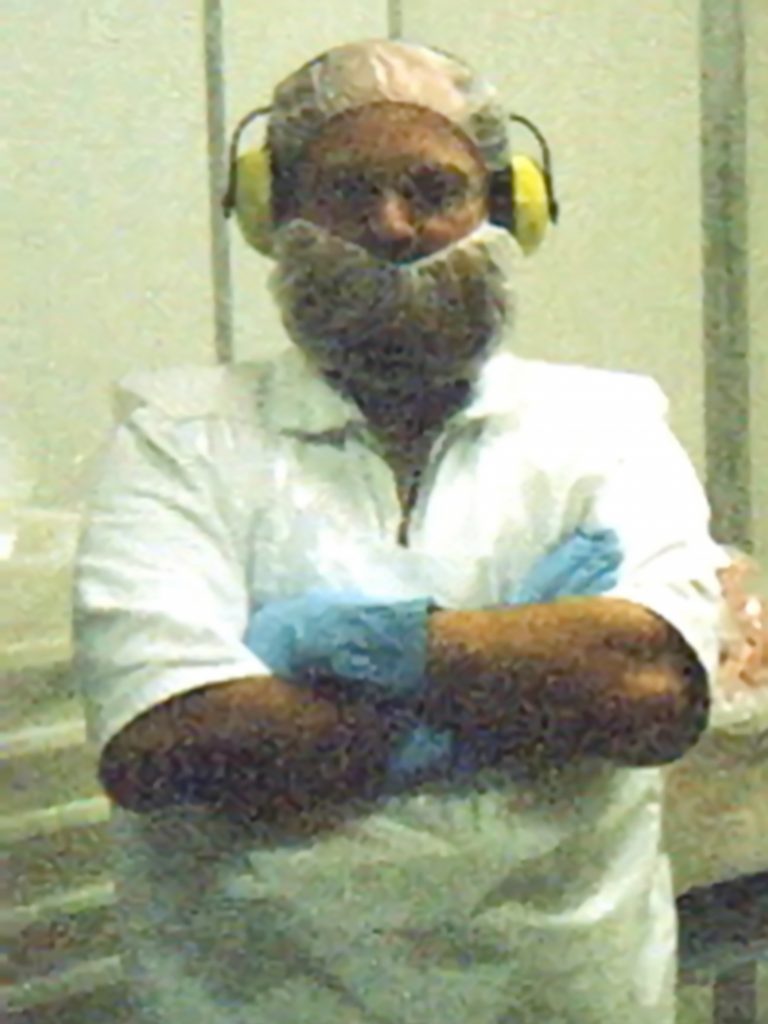
Photo of Carl when he worked in the boning room during his mid-30s at Silverstream Meatworks near Dunedin.
Q3: Do you think it was a well-run and well-regulated slaughterhouse?
I don’t have much to compare it to, apart from another slaughterhouse I worked at in the mid-2000s while I was in my mid-30s. That was Silverstream ‘meatworks’, (another Kiwi term for a slaughterhouse), near Dunedin. It was a much more modern and better run slaughterhouse than Pukeuri.
Health and safety was pretty slack at Pukeuri, but at Silverstream standards were better. I never really saw what happened in the ‘stockyards’ at Pukeuri, and Silverstream didn’t kill the animals on site, so I don’t know about their animal welfare practices. But I did see a lot of botched killings at Pukeuri. A high percentage of the animals died pretty horrific deaths. I’ll spare you the details, but I don’t use the word ‘horrific’ lightly.
As far as quality control goes, the meat inspectors at Pukeuri often used to laugh and joke around and have a casual attitude that led to them not doing their job properly. I’m sure many of the dead bodies would have ended up being exported with pus and shit on them, and broken bones and diseases and so on.
Speaking of diseases… Animals from certain farms would come in with cysts on them, which were basically infected lymph nodes. Some of these cysts were enormous. They could be the size of a grapefruit. They were full of this revolting yellow-green puss, which was the most foul-smelling substance I have ever smelled! Seriously. If there is a worse smelling substance I don’t know what it is. I would gag and wretch and almost vomit sometimes when I was dealing with it. Quite often these big cysts would burst and spray their contents out onto the animals, the equipment, and occasionally onto us. It was hideous.
Speaking of diseases… Animals from certain farms would come in with cysts on them, which were basically infected lymph nodes. Some of these cysts were enormous. They could be the size of a grapefruit. They were full of this revolting yellow-green puss, which was the most foul-smelling substance I have ever smelled! Seriously. If there is a worse smelling substance I don’t know what it is. I would gag and wretch and almost vomit sometimes when I was dealing with it. Quite often these big cysts would burst and spray their contents out onto the animals, the equipment, and occasionally onto us. It was hideous.
Animals with bruises and broken bones would often come through too, and there were often animals with dog bites on their bum. Some of the sheep had live maggots crawling in their bums as a result of being fly blown. Some animals had parasites in their bodies, and others had pleurisy or other diseases.
These problems seemed to correlate with the farms they came from. You could tell because the sheep and lambs came through in batches. It was obvious that some of the farmers didn’t care very much, and weren’t trying very hard. It was disturbing to think that they had been suffering on the farm, then again on the trucks, and then finally at the slaughterhouse where they met their violent, terrifying death.
Q4: Looking back, how would you describe the workplace culture?
I think some people have a perception of what people who work in slaughterhouses are like. Some people think you have to be some sort of monster to work in those places. But the truth is, most of them were nice people. There were a few idiots at both slaughterhouses, but you get idiots in any industry. The majority of them were reasonably decent people. People there do become quite desensitised though. You have to really, or you wouldn’t be able to sleep at night.
Some people I met had university degrees. One guy I worked with was a concert pianist. He was a gentle, cultured, softly spoken young man who was working there only because he couldn’t make enough money from his music. You could say there was a certain macho workplace culture at Pukeuri and Silverstream, but perhaps not as bad as you might expect. But we were definitely desensitised. No-one ever expressed concern about the animals. I think you would have been laughed at if you did.
Some people I met had university degrees. One guy I worked with was a concert pianist. He was a gentle, cultured, softly spoken young man who was working there only because he couldn’t make enough money from his music. You could say there was a certain macho workplace culture at Pukeuri and Silverstream, but perhaps not as bad as you might expect. But we were definitely desensitised. No-one ever expressed concern about the animals. I think you would have been laughed at if you did.
I remember one incident where a young lamb escaped from the kill floor and ran up to where we were working on the mutton chain. The poor thing was terrified and confused, not knowing where to go or what to do. I found it quite disturbing that a lot of the workers started laughing. Some of them were so hardened and desensitised, they didn’t seem to have any empathy. I couldn’t laugh though. Even though I had become quite desensitised, I knew the lamb would have been terrified.
Q6: How did you feel about your job as you were doing it?
My dad was a hunter, so I had grown up around dead and dying animals. I had trapped possums as a kid, and although I never enjoyed it, I had gotten used to killing. It all seemed kind of normal to me. Still, there were moments at the freezing works that disturbed me. Watching the sheep and cattle being killed was not a nice experience. A lot of them died awful deaths. And seeing the injuries and disease on the detain rail was a stark reminder of the suffering they had endured on the farms and the trucks.
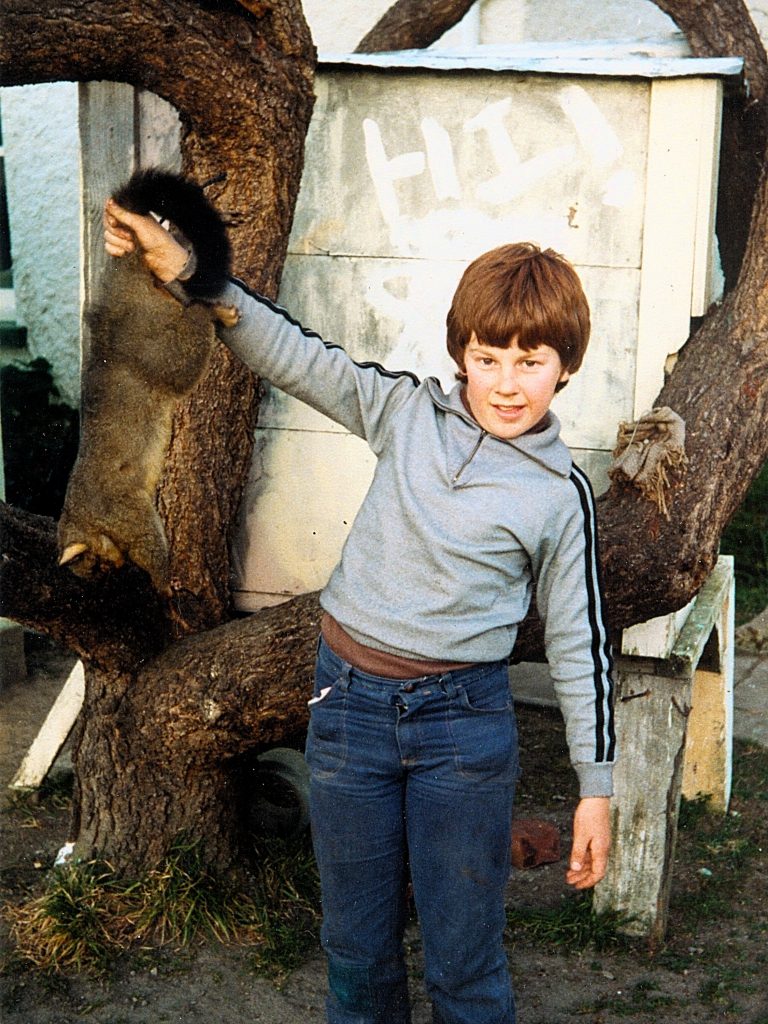
Surrounded by dead and dying animals most of his life, trapping possums seemed normal to 12 year old Carl.
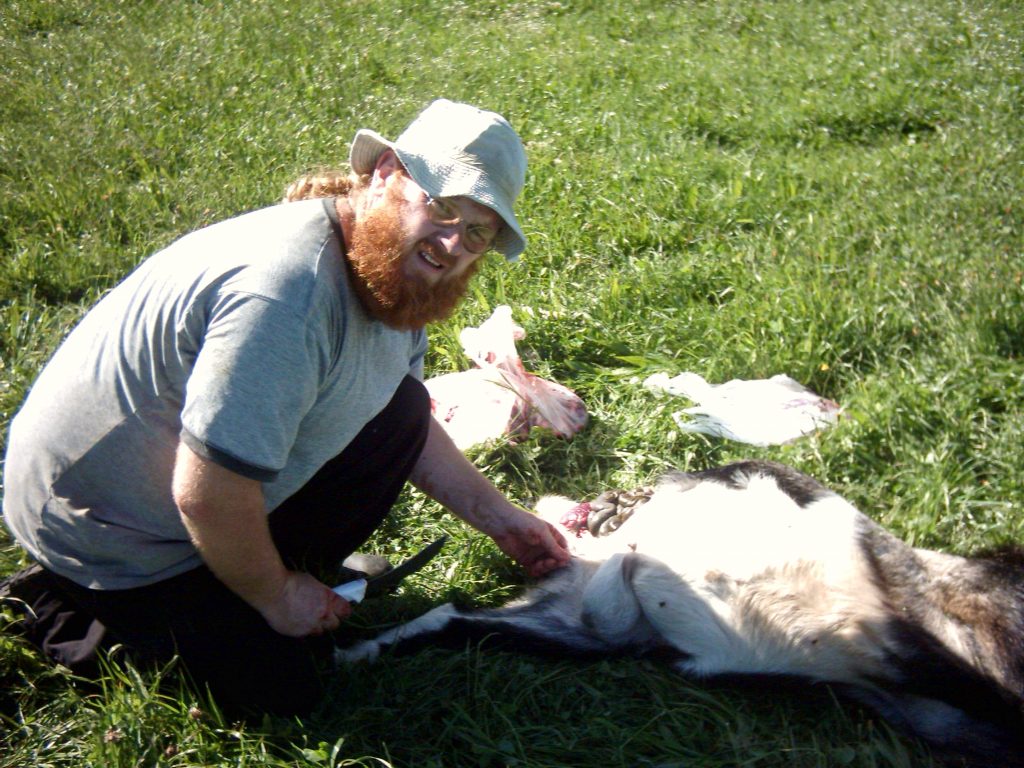
Carl butchering a goat.
But mainly it was just an unbelievably boring job. It was hot, noisy, smelly, repetitive, and mind-numbingly boring. A lot of us used small radios or ‘walkmans’, (portable tape cassette players), with headphones, to relieve the monotony. Workers also chatted to each other, but I wasn’t a very sociable person. As a young man I was shy and awkward and didn’t talk very much. I used my walkman while I was working, and in the smoko room I would usually just read books.
Repetitive strain injuries were quite common, and I ended up with significant pain in my wrists and hands at one stage from pulling fat off from around the kidneys. Cuts from knives were also very common. We probably saw an average of two or three cuts a day. Usually we would just put a sticking plaster on, but occasionally someone would cut themselves so badly they needed stitches.
I hated the job. Mostly because of the boredom and monotony, but also the heat and noise. It was not a nice working environment. I also never felt like I was contributing to the world much. It was just something I did to pay the bills. I definitely didn’t want to be a freezing worker for the rest of my life, so at the age of 23 I went back to high school as an adult student. But to be honest, I would have done just about anything to get the hell out of there.
Q7: Were your days long?
The days were quite long. I lived in Waimate, which is about a 50 minute drive from Pukeuri. Most of us travelled in the bus the slaughterhouse provided, and then took the bus home again at the end of the day. I had to get up quite early, and didn’t get home till late in the day.
On arrival we would collect our uniform, then go up 4 stories to the top of the building to the locker room. There we’d put on our white pants, shirt, hat, and gumboots, then we’d go up to the smoko room and wait for the start of our shift. We worked for eight hours, with fifteen minute breaks for morning and afternoon smoko, and a half hour for lunch. Even knowing about the blood and the guts and the pus and shit, I would still buy mutton pies for lunch. You just become that desensitised.
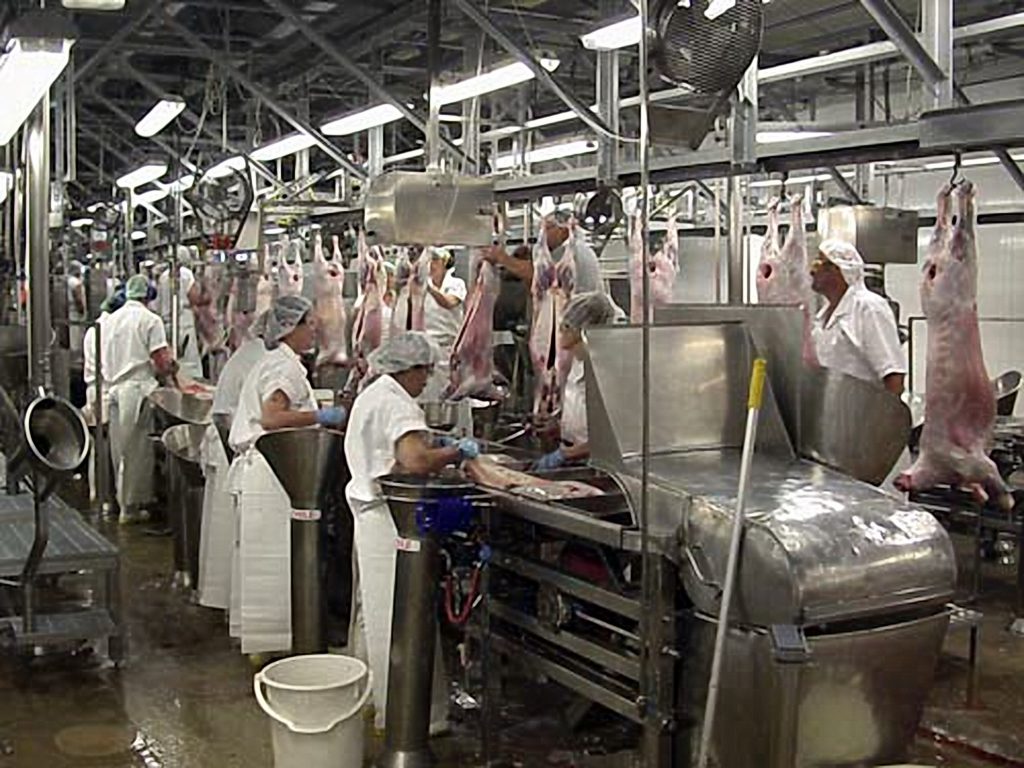
The “gut trays’ which Carl worked on, on the mutton processing chain at Pukeuri.
Q8: How did you go from being a slaughterhouse worker to a vegan animal rights activist?
I think I was always an empathic person. I hate seeing anyone suffer. And I think my involvement with a Christian church and the Scouting movement when I was younger helped me develop a reasonably strong moral compass. Having family pets helped me develop a rudimentary understanding of other animals, and some degree of empathy for them.
I remember seeing campaign material from SAFE, (and possibly the NZSPCA), about factory farming. That was probably in the 1990s or early 2000s. As a result, I became quite committed to only buying free range animal products, because that’s what those organisations were telling us to do. They weren’t talking about veganism back then for some reason. But it does go to show how important activism is. You never know what seeds you might be planting.
A huge influence for me though, was a relationship I had with a dog named Jed. That was in my 30s and early 40s. He initially lived with my ex, Karen, and her son Ethan. I got to know Jed when I was spending time with Karen, and formed a real bond with him. In the last 4 years of his life he lived with me at Waitati, and we were best buddies. We were practically joined at the hip. Knowing him helped me develop a much deeper understanding of other animals, and therefore a far greater respect for them.
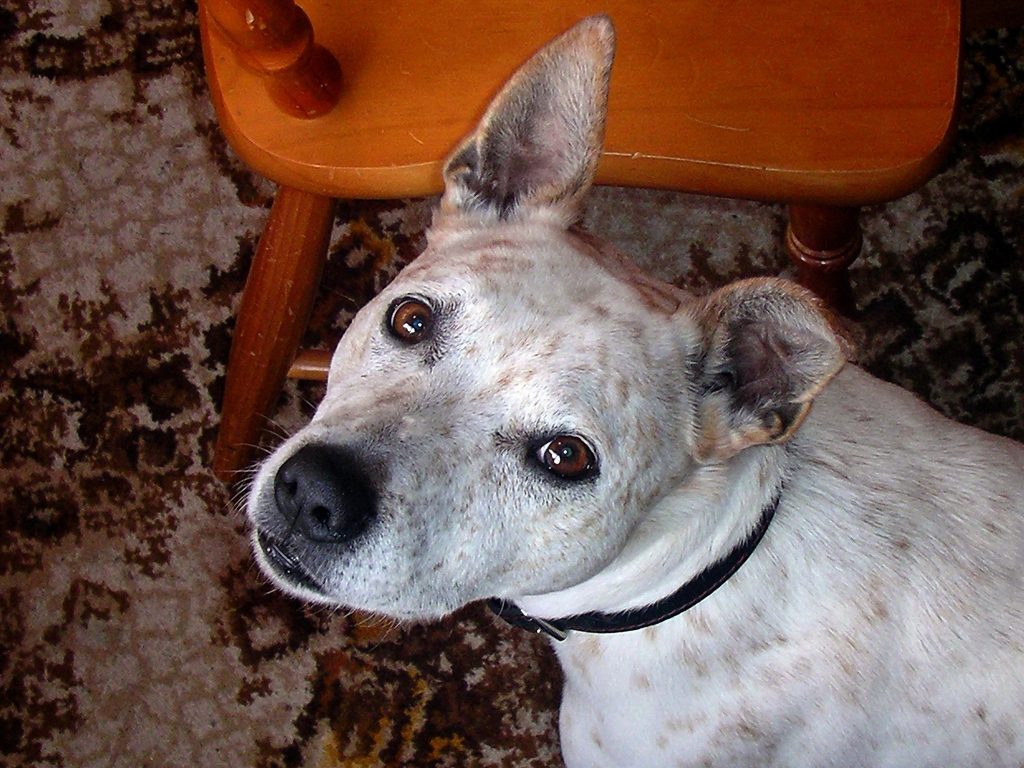
- Jed, the first non-human Carl really bonded with.
But the reason I eventually went vegan is definitely not your typical story. It was actually a ‘spiritual experience’ of sorts. I was living in Waitati, and I was at a crossroads in my life. I sent a prayer to the Universe asking for guidance. I was basically asking, “What should I be doing with my life right now?”
After a while, the word ‘vegan’ started popping up on my radar. I went to see a public talk by a spiritual teacher in the Waitati Hall, and that night, (or was it the next night?), I had a very powerful dream. I was chatting with some kind of holy person – maybe Jesus or the Buddha or someone like that – and right at the end I turned to them and said, “I’m going to be vegan.” I burst into tears and this incredible feeling of, “This just feels so right,” washed over me in a powerful wave. I woke up suddenly, and somehow I just had a deep knowing that that was the answer I had been praying for.
I resisted at first. “Me? Vegan? I can’t do that!” I thought veganism seemed a bit extreme, and that it would probably be very difficult. So I compromised and went vegetarian. But after 6 days, it just didn’t feel right. I was out walking with Jed and I found myself thinking, “You asked for an answer Carl, and you got one. And it wasn’t vegetarian. You need to at least give this vegan thing a damned good go”. The moment I made that decision, the exact same feeling I’d had in the dream came over me. It was a powerful physical feeling. The feeling of, “This just feels so right.” That was on the 27th of May 2010. It’s almost 12 years now that I’ve been vegan, and I’ve never looked back.
I resisted at first. “Me? Vegan? I can’t do that!” I thought veganism seemed a bit extreme, and that it would probably be very difficult. So I compromised and went vegetarian. But after 6 days, it just didn’t feel right. I was out walking with Jed and I found myself thinking, “You asked for an answer Carl, and you got one. And it wasn’t vegetarian. You need to at least give this vegan thing a damned good go”. The moment I made that decision, the exact same feeling I’d had in the dream came over me. It was a powerful physical feeling. The feeling of, “This just feels so right.” That was on the 27th of May 2010. It’s almost 12 years now that I’ve been vegan, and I’ve never looked back.
If anyone can tell me a weirder story of how someone became vegan, I will honestly be very impressed. Ha ha ha. But that’s what happened. Your readers can make whatever they want of it.
Q9: You’re well known for being ‘The Man in the Cage’. Tell us about what made you decide to do that?
That was eleven years ago in March and April 2011. I had been vegan for less than a year. In late 2010 I read a thing on Facebook that described the life of a battery hen, and even if it was only half that bad as that, it still sounded utterly horrific. Utterly intolerable. I was both upset and outraged.
I realised the Mainland Poultry egg farm at Waikouaiti – NZ’s largest battery farm – was just up the road from where I was living. I thought, “I can’t bear this. I have got to do something!” I didn’t know what. But something.
It’s a little embarrassing to admit, but my first idea was to kidnap one of the directors of Mainland Poultry and force them to live in a cage. I even started jotting some ideas about how to do it. I know. Crazy, right? But fortunately, I eventually thought better of it. I knew I couldn’t do that. So I was walking around a friend’s garden pondering what I could do instead. I honestly couldn’t think of anything and eventually I just gave up.
But a funny thing happened. At that moment of surrender, when my mind finally went still and quiet, a voice popped into my head – it was almost an audible voice, but not quite – that said: ‘Put yourself in the cage’.
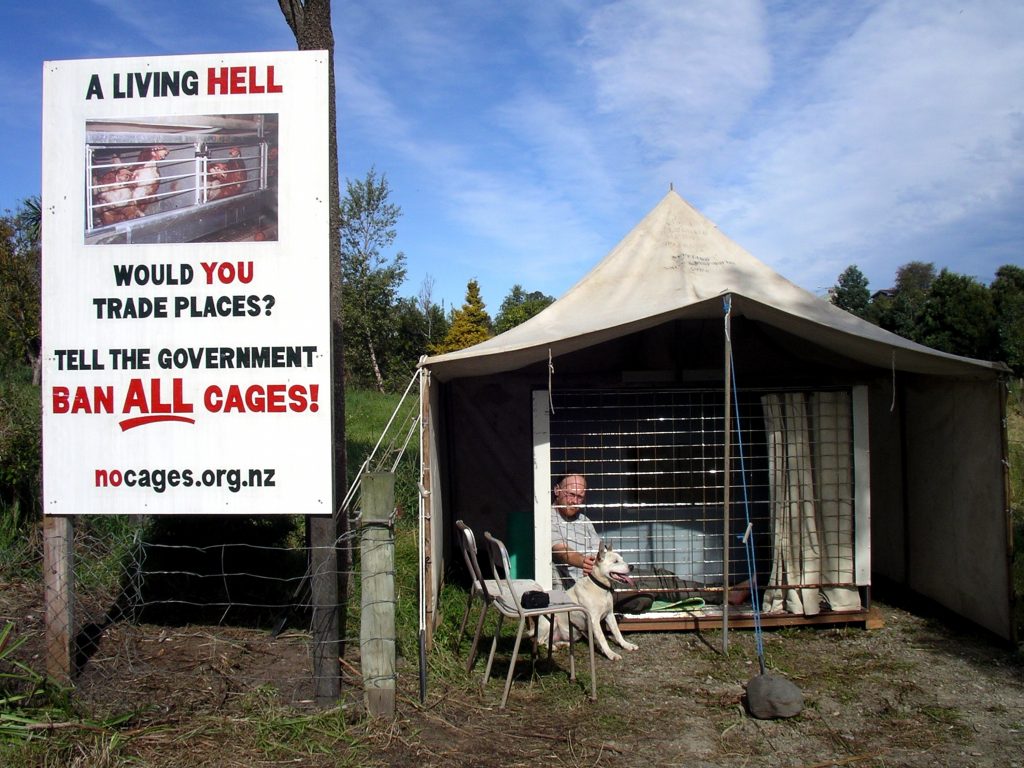
I remember feeling like it was a spiritual insight of some sort. It had this real feeling like someone or something was telling me that is what I needed to do. When I was studying history at school I had learned about Martin Luther King Jr. and Gandhi. Their philosophy was, rather than to inflict suffering for a cause, it is better to endure suffering for the cause. So I got Gandhi’s autobiography out from the library, to try and get my head around his concepts of ‘satyagraha’ and non-violence.
Then in early 2011, the National Animal Welfare Advisory Committee (NAWAC) announced a proposal to replace conventional battery cages with colony battery cages. They are a total sham. They are hardly any better than conventional cages, but NAWAC had opened up a process asking for submissions from the public about the proposal.
The timing all seemed to come together, and I felt like, “If I’m ever going to do that thing about sitting in a cage, now would be the perfect time to do it.” I wrestled with myself a bit though. I found myself thinking “This is crazy. I can’t do this!” But I felt like it was something I was being guided to do by some kind of higher power or something. So I did it. I spent a month in the cage. Thirty-one days. The last day of my vigil was the 29th of April: the day that submissions to NAWAC closed.
I took a few books into the cage with me because I thought boredom was going to be a problem, but the fact is I have never been so busy in my life while sitting down. I set my cage up on the side of the road on State Highway One, in the township of Waikouaiti where the huge battery farm is.
There was a lot of traffic going past, and a lot of people stopped and chatted. Friends, family, and locals would also come to visit me. I have Chronic Fatigue Syndrome, so sometimes I would be so exhausted, that I’d pull the curtain across the cage and hope no-one would bother me for a while. I also drank a lot of coffee!
Friends and family would bring me food and other supplies. My mum and my uncle Matt were my two main ‘support crew’ but others helped too.
During the entire month I only spent about two hours total outside of the cage. The chickens can’t please themselves, so to make it as authentic as possible, I decided I wouldn’t either. I had sponge baths, and even went to the toilet in the cage. I relied on family members and a few good friends to come and empty my toilet buckets into a big hole I had dug in the paddock out the back.
Another thing that kept me busy was the internet, thanks to neighbours who let me run an extension cord from their garage. I spent a lot of time on Facebook, sending and receiving emails, and doing phone calls and media interviews.
I did interviews with with TV One, TV Three, and the local TV station, Channel 39: Dunedin Television. I was also on Marcus Lush’s radio show once. I had a friend, Helen, who was a schoolteacher and she organised a phone conversation with the girls in her class one day. I also had a visit from a bunch of kids from the Karitane school one day. On a couple of occasions the local SAFE volunteers joined me for a few hours holding signs and wearing chicken costumes. I never got time to read the books I had!
It was a long month, but I think having been in the army for five years stood me in good stead. In the army sometimes you often have to push yourself to the limits of your endurance, and so you learn to cope with challenge and adversity. And although I found the cage protest to be easier than some people might imagine, it definitely was very challenging at times.
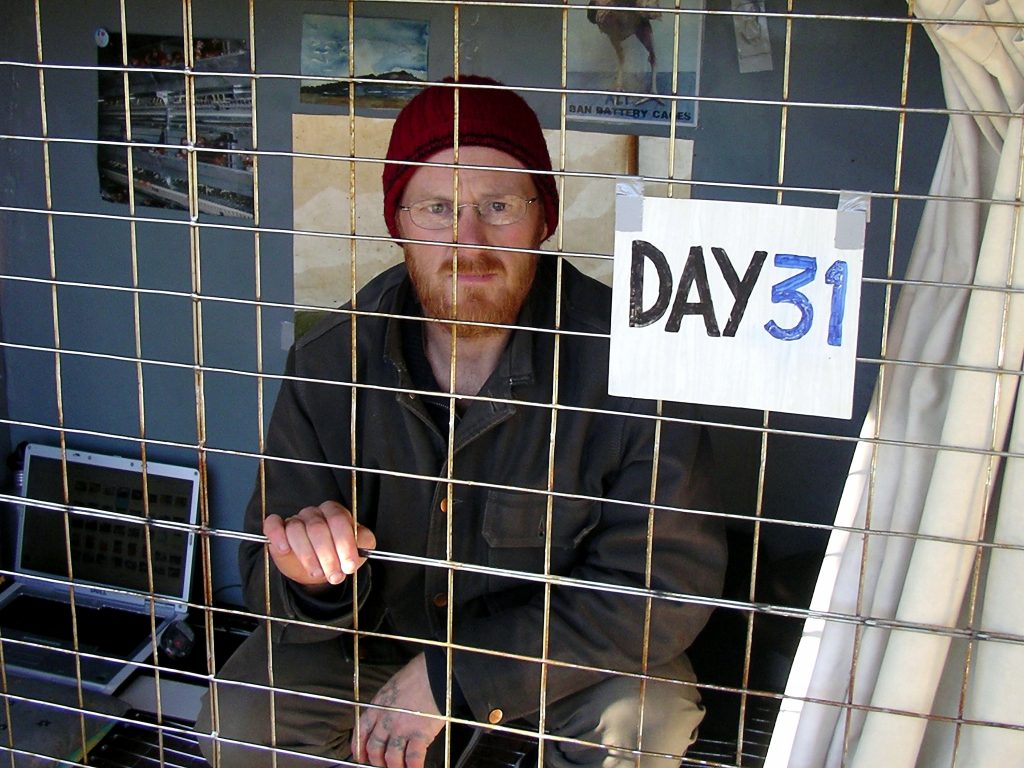
Carl stayed a full month in his cage on the side of a main highway. The total time out of the cage in that time wouldn’t have been more than a couple of hours.
Q10: Do you feel your action was effective?
It’s hard to know really. But I do know that it raised a lot of awareness: especially on mainstream media and social media. At that stage SAFE and NZ Open Rescue (NZOR) were trying to raise awareness about colony cages, saying they didn’t meet basic welfare requirements. Deirdre Sims and Marie Brittain from NZOR had done a lock-on on a battery farm silo, and some other actions, to get the word out. SAFE was running a campaign too.
In 2011 practically nobody had ever heard of colony cages, so between my vigil, SAFE, and NZOR, we got people talking about them. I also got over 1,000 people to sign postcards which SAFE had provided, and I sent them to NAWAC. A number of people also sent emails to NAWAC because of my campaign, and I sent them a long email submission myself. One very cool young girl got heaps of kids from her nearby school to sign a petition to NAWAC as a result of my vigil.
It was the first major thing I’d ever done as an AR activist. The only other thing I’d done before that was to attend one SAFE volunteer meeting. Seriously. That was it. I barely knew anyone in the movement. I have been told that at first a lot of AR activists in the NZ movement were thinking, ‘Who is this guy? Is he some kind of a nut job? Is he going to be an embarrassment to us?’ And frankly, I don’t blame them. It was definitely an unusual thing to do.
But I have also been told that after I gave my first media interviews, everyone was quite relieved to learn that I wasn’t in fact an embarrassing nut job. In fact, they loved what I was doing, and loads of activists from around NZ got in behind me and supported me in all sorts of ways. SAFE were especially supportive.
Once I had established some credibility, after I completed my protest I got asked to speak at conferences and expos, do media interviews, write articles, speak to different groups, and so on. So there have been many opportunities to discuss veganism and animal rights since my cage vigil ended.
I love the Gandhi quote, “You may never know the results of your actions but if you do nothing there will be no results.” My philosophy is ‘Do what you can, with what you have, where you are.’ That’s all we can do really.
Eventually, of course, we lost the battle and colony cages got passed into law. Thousands of good Kiwis submitted their opposition to colony cages, but we were ignored, and the 43 egg farmers using cages got what they wanted.
That was the first time in my life it really hit home to me how our supposed democracy is often not really the ‘government of the people, by the people, for the people’ that it is supposed to be. I discovered that the reality is, it is often controlled by wealthy, powerful business people who tend to get what they want. I feel the action helped me to grow as a person though, and I know I got a lot more people talking about veganism. Right from the start I always used the word ‘vegan’ a lot. It is funny to think about it now, but in 2011 most animal rights groups in NZ were not using that word much, if at all. Even SAFE wasn’t using ‘the dreaded v word’ – as some people called it back then – very often.
That was the first time in my life it really hit home to me how our supposed democracy is often not really the ‘government of the people, by the people, for the people’ that it is supposed to be. I discovered that the reality is, it is often controlled by wealthy, powerful business people who tend to get what they want. I feel the action helped me to grow as a person though, and I know I got a lot more people talking about veganism. Right from the start I always used the word ‘vegan’ a lot. It is funny to think about it now, but in 2011 most animal rights groups in NZ were not using that word much, if at all. Even SAFE wasn’t using ‘the dreaded v word’ – as some people called it back then – very often.
But I used it a lot. Right from the start I’ve talked about veganism and rights, rather than welfare reforms. In 2013 at the national NZ animal rights conference I gave a speech about how we need to be talking about veganism more, and a lot of other activists agreed with me. I think over the years I have probably played a significant part in helping shift the NZ AR movement’s narrative in that direction.

Carl speaking to the Auckland Animal Rights March in 2018
Q11: Carl, it’s no secret to those who know and love you that things haven’t been easy for you in your journey, and you’ve fought some personal battles. Do you want to say any more about this?
Sure. I don’t mind talking about it. I’ve had mental health struggles on and off since I was 19 years old. I had a couple of minor psychotic episodes between the ages of 19 and 22, and I’ve also had battles with depression and anxiety on and off throughout most of my adult life.
I’ve also had Chronic Fatigue Syndrome (CFS) from the age of 27. I think it just goes to show though, many people with mental health issues and physical health challenges, can still make valuable and meaningful contributions to society.
During my activism career, I have suffered from stress and burnout several times. I knew I was burning out when I was feeling anxious, stressed, grumpy and irritable, and depressed and exhausted all the time. For the past few years it has been rare to have a day when I feel like a normal person.
Eventually I ended with a bit of a drinking problem, although I’ve managed to get that under control now. I also started smoking cigarettes again, after being smoke free for 15 years. I also ended up with heart disease, partly because of the stress and burnout.
For the longest time, I still couldn’t quit my activism though, even though all the signs were telling me I needed to. I was just utterly driven to keep going. I felt compelled to keep working, because I have been inside the factory farms of NZ and have worked in a couple of slaughterhouses. I have seen the horror first-hand and I know how truly awful it really is.
I have often said, “The animals in factory farms are not moderately uncomfortable. They are not slightly unhappy. Their lives are a living hell.” And that is the hideous truth of it.I know how many animals are suffering, how badly they suffer, and how few activists there are who are doing anything to help them. So I pushed myself and pushed myself until I simply couldn’t any more. But eventually I had to stop. I had no choice. So I’m semi-retired from activism for now.
I have often said, “The animals in factory farms are not moderately uncomfortable. They are not slightly unhappy. Their lives are a living hell.” And that is the hideous truth of it.I know how many animals are suffering, how badly they suffer, and how few activists there are who are doing anything to help them. So I pushed myself and pushed myself until I simply couldn’t any more. But eventually I had to stop. I had no choice. So I’m semi-retired from activism for now.
For the next year or so, or maybe even more, I want to concentrate on getting myself well again. I’m trying to be proactive though. I’m working on improving my diet, (vegans can still eat too much vegan junk food, you know!), getting enough good quality sleep, doing more exercise, etc., and I’ve been putting things in place to get some counselling.
The reason I think it’s important to be open about my mental health and burnout is because I know I’m not the only AR activist who has experienced these things. I’d like to see more activists, and would love to see activists doing more, but it’s important to recognise that there are limits to what one person can do.
Burnout is a very real and very serious thing. The animals, the planet, and people, need as many of us as possible to do as much as we can. But we absolutely must practise self-care, and support each other in order to prevent burnout.
Q12: Do you have anything else you’d like to say?
To any non-vegans out there who read this, I would say that what our ancestors did, or what lions do is utterly irrelevant. They either literally had no choice, or they simply didn’t know any better.
But we do have a choice, and we do know better. There is no need in the 21st century, in a wealthy industrialised country like NZ, to exploit animals for food, clothing, entertainment, or any other purpose. That’s not an opinion or a belief. That’s a scientific fact. There are other ways to meet our needs.
So I would encourage you to be vegan. It’s not as hard as most people think. I promise you that. Being vegan is not only morally and ethically ‘the right thing to do’, it is also one of the most powerful things we can do as individuals to save the planet!
If you’re already vegan, then I would encourage you to please get active for the animals. They need every activist they can get. You don’t have to sit in a cage for a month, or get arrested or anything like that, if you don’t want to. I mean, you can if you want to; but if that’s not your cup of tea, there are all sorts of other things you can do. You can create online content, or simply just post and share stuff on social media. You can wear a vegan t-shirt, talk to friends and neighbours, or whatever. Get creative. Think outside the box. Do some Googling. Just be as active as you can in whatever ways you’re comfortable with. Like drops in a bucket, it all adds up. It all helps.
If you’re already vegan, then I would encourage you to please get active for the animals. They need every activist they can get. You don’t have to sit in a cage for a month, or get arrested or anything like that, if you don’t want to. I mean, you can if you want to; but if that’s not your cup of tea, there are all sorts of other things you can do. You can create online content, or simply just post and share stuff on social media. You can wear a vegan t-shirt, talk to friends and neighbours, or whatever. Get creative. Think outside the box. Do some Googling. Just be as active as you can in whatever ways you’re comfortable with. Like drops in a bucket, it all adds up. It all helps.
To those who are already active I would say, if you are able to, then please, ‘Get serious!’ Radical, controversial action is what gets results. It gets the public, the politicians, the media, and the business world talking. Martin Luther King Jr., the Women’s Suffrage movement, and countless other activists and movements throughout history have proven that. I know that not everyone can do that work. But some people can, and if they want to, then they should. Because it works.
But it’s not just all about being radical. It’s also about working smarter. I really believe the future of the global animal rights movement has to be highly organised pressure campaigns. But that’s a whole other story…
If anyone does want to try some of the more controversial types of activism, in NZ we have people like the Farmwatch crew, some of the members of DAA, and others, who have many years of experience doing that work. They have learned how to do it safely and effectively, and many of them will be more than happy to advise you.
I have 15 years of activism experience myself, and I’m also willing to talk to or advise anyone who wants to engage in any form of activism, including the more radical types of work. If you want to bounce some ideas off me, or ask me any questions, feel free to get in touch. I might not always be able to help, but if I can I will.
It has been said that, “All that is necessary for evil to triumph, is that good people do nothing.” So each of us must do what we can. No-one can do everything, but everyone can do something. If you can do big things, then great! But if you can’t do big things, you can do small things in a great way.
Step 1: Be Vegan. Step 2: Get Active. Step 3: Get serious. The animals, the planet, and even the people who suffer because of the animal exploitation industries need all the vegans and all the activists they can get.
Thankyou for your time, Carl.
Comments
Comments are closed.
← NEXT


Peter Cooper says:
Thank you so much for telling your story Carl.
Very insightful.
Sandra Kyle says:
Agreed, Peter!
Marina says:
Thank you!!! You should write a book!!! You have an incredible story ! 🌱